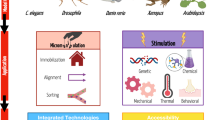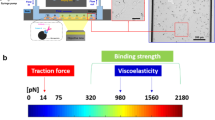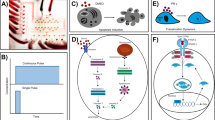Abstract
This protocol describes the production and operation of a microfluidic dissection platform for long-term, high-resolution imaging of budding yeast cells. At the core of this platform is an array of micropads that trap yeast cells in a single focal plane. Newly formed daughter cells are subsequently washed away by a continuous flow of fresh culture medium. In a typical experiment, 50–100 cells can be tracked during their entire replicative lifespan. Apart from aging-related research, the microfluidic platform can also be a valuable tool for other studies requiring the monitoring of single cells over time. Here we provide step-by-step instructions on how to fabricate the silicon wafer mold, how to produce and operate the microfluidic device and how to analyze the obtained data. Production of the microfluidic dissection platform and setting up an aging experiment takes ∼7 h.
This is a preview of subscription content, access via your institution
Access options
Subscribe to this journal
Receive 12 print issues and online access
$259.00 per year
only $21.58 per issue
Buy this article
- Purchase on Springer Link
- Instant access to full article PDF
Prices may be subject to local taxes which are calculated during checkout





Similar content being viewed by others
Change history
13 May 2013
In the version of this article initially published online, the author name for Javier González was misspelled as Gonzáles. The error has been corrected in the print, PDF and HTML versions of the article.
References
Lee, S.S., Avalos Vizcarra, I., Huberts, D.H., Lee, L.P. & Heinemann, M. Whole lifespan microscopic observation of budding yeast aging through a microfluidic dissection platform. Proc. Natl. Acad. Sci. USA 109, 4916–4920 (2012).
Zhang, Y. et al. Single cell analysis of yeast replicative aging using a new generation of microfluidic device. PLoS ONE 7, e48275 (2012).
Rafelski, S.M. et al. Mitochondrial network size scaling in budding yeast. Science 338, 822–824 (2012).
Hersen, P., McClean, M.N., Mahadevan, L. & Ramanathan, S. Signal processing by the HOG MAP kinase pathway. Proc. Natl. Acad. Sci. USA 105, 7165–7170 (2008).
Unger, M.A., Chou, H.P., Thorsen, T., Scherer, A. & Quake, S.R. Monolithic microfabricated valves and pumps by multilayer soft lithography. Science 288, 113–116 (2000).
Cookson, S., Ostroff, N., Pang, W.L., Volfson, D. & Hasty, J. Monitoring dynamics of single-cell gene expression over multiple cell cycles. Mol. Syst. Biol. 1, 2005.0024 (2005).
Ryley, J. & Pereira-Smith, O.M. Microfluidics device for single cell gene expression analysis in Saccharomyces cerevisiae. Yeast 23, 1065–1073 (2006).
Lee, P.J., Helman, N.C., Lim, W.A. & Hung, P.J. A microfluidic system for dynamic yeast cell imaging. Biotechniques 44, 91–95 (2008).
Charvin, G., Cross, F.R. & Siggia, E.D. A microfluidic device for temporally controlled gene expression and long-term fluorescent imaging in unperturbed dividing yeast cells. PLoS ONE 3, e1468 (2008).
Rowat, A.C., Bird, J.C., Agresti, J.J., Rando, O.J. & Weitz, D.A. Tracking lineages of single cells in lines using a microfluidic device. Proc. Natl. Acad. Sci. USA 106, 18149–18154 (2009).
Mortimer, R.K. & Johnston, J.R. Life span of individual yeast cells. Nature 183, 1751–1752 (1959).
Steffen, K.K., Kennedy, B.K. & Kaeberlein, M. Measuring replicative life span in the budding yeast. J. Vis. Exp. http://dx.doi.org/10.3791/1209 (2009).
Medvedik, O. & Sinclair, D.A. Caloric restriction and life span determination of yeast cells. Methods Mol. Biol. 371, 97–109 (2007).
Kennedy, B.K., Austriaco Jr. N.R. & Guarente, L. Daughter cells of Saccharomyces cerevisiae from old mothers display a reduced life span. J. Cell Biol. 127, 1985–1993 (1994).
Tai, S.L., Daran-Lapujade, P., Walsh, M.C., Pronk, J.T. & Daran, J.M. Acclimation of Saccharomyces cerevisiae to low temperature: a chemostat-based transcriptome analysis. Mol. Biol. Cell 18, 5100–5112 (2007).
Vanoni, M., Vai, M., Popolo, L. & Alberghina, L. Structural heterogeneity in populations of the budding yeast Saccharomyces cerevisiae. J. Bacteriol. 156, 1282–1291 (1983).
Xie, Z. et al. Molecular phenotyping of aging in single yeast cells using a novel microfluidic device. Aging Cell. 11, 599–606 (2012).
McDonald, J.C. & Whitesides, G.M. Poly(dimethylsiloxane) as a material for fabricating microfluidic devices. Acc. Chem. Res. 35, 491–499 (2002).
Tyson, C.B., Lord, P.G. & Wheals, A.E. Dependency of size of Saccharomyces cerevisiae cells on growth rate. J. Bacteriol. 138, 92–98 (1979).
Jorgensen, P., Nishikawa, J.L., Breitkreutz, B.J. & Tyers, M. Systematic identification of pathways that couple cell growth and division in yeast. Science 297, 395–400 (2002).
Minois, N., Frajnt, M., Wilson, C. & Vaupel, J.W. Advances in measuring lifespan in the yeast Saccharomyces cerevisiae. Proc. Natl. Acad. Sci. USA 102, 402–406 (2005).
Kaeberlein, M., Kirkland, K.T., Fields, S. & Kennedy, B.K. Genes determining yeast replicative life span in a long-lived genetic background. Mech. Ageing Dev. 126, 491–504 (2005).
Shcheprova, Z., Baldi, S., Frei, S.B., Gonnet, G. & Barral, Y. A mechanism for asymmetric segregation of age during yeast budding. Nature 454, 728–734 (2008).
Kaplan, E.L. & Meier, P. Nonparametric estimation from incomplete observations. J. Am. Stat. Assoc. 53, 457–481 (1958).
Polymenis, M. & Kennedy, B.K. Cell biology: high-tech yeast ageing. Nature 486, 37–38 (2012).
Mantel, N. Evaluation of survival data and two new rank order statistics arising in its consideration. Cancer Chemother. Rep. 50, 163–170 (1966).
Acknowledgements
We would like to thank M. Peter and U. Sauer for generously allowing us the use of the microscope; FIRST-CLA at ETH Zurich for the clean room facility during the development of this protocol; L. Lee for initial discussions; and N. Thayer, A. Papagiannakis and A. Meinema for helpful comments on the manuscript. Funding from the NWO-funded Groningen Systems Biology Center for Energy Metabolism and Ageing is acknowledged.
Author information
Authors and Affiliations
Contributions
S.S.L. invented the microfluidic dissection method; I.A.V., G.E.J. and D.H.E.W.H. helped to further develop the protocol; J.G. introduced the statistical analyses; M.H. supervised the project; S.S.L., D.H.E.W.H. and M.H. wrote this protocol.
Corresponding author
Ethics declarations
Competing interests
The authors declare no competing financial interests.
Rights and permissions
About this article
Cite this article
Huberts, D., Sik Lee, S., González, J. et al. Construction and use of a microfluidic dissection platform for long-term imaging of cellular processes in budding yeast. Nat Protoc 8, 1019–1027 (2013). https://doi.org/10.1038/nprot.2013.060
Published:
Issue Date:
DOI: https://doi.org/10.1038/nprot.2013.060
This article is cited by
-
Temporal segregation of biosynthetic processes is responsible for metabolic oscillations during the budding yeast cell cycle
Nature Metabolism (2023)
-
Differential scaling between G1 protein production and cell size dynamics promotes commitment to the cell division cycle in budding yeast
Nature Cell Biology (2019)
-
Quantitative characterization of the auxin-inducible degron: a guide for dynamic protein depletion in single yeast cells
Scientific Reports (2017)
-
RNA polymerase III limits longevity downstream of TORC1
Nature (2017)
-
Microfluidics: reframing biological enquiry
Nature Reviews Molecular Cell Biology (2015)
Comments
By submitting a comment you agree to abide by our Terms and Community Guidelines. If you find something abusive or that does not comply with our terms or guidelines please flag it as inappropriate.



